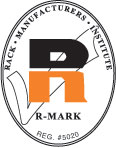Today’s solutions are Not your father’s pallet racking
Pallet rack is the most popular and versatile type of storage rack, providing immediate accessibility to every pallet load.
But the storage solutions they provide today not only maximize storage space but have a significant impact on your operation’s ability to maximize inventory turns, minimize product on hand and facilitate rapid fulfillment.
A Good Racking System Optimizes Order Picking
In terms of picking applications, pallet racking systems have come a long way. Integrating order fulfillment systems with racking systems is now the norm.
During this process, product is moved from pallet racks through the system before being broken into cartons and pieces, where they are sent to pick areas for processing and shipment. This flow-through concept allows distribution operations to be consolidated into one facility that handles all of the logistics and helps to lower fulfillment costs. The system maximizes the use of space and labor and delivers an organized flow of products being readied for shipment.
Combining new technologies (such as wireless, GPS and Bluetooth) with racking has enabled systems to be reengineered to be more flexible, cost effective and efficient. For example, an old mole shuttle system ran throughout a rack structure on a set of pulleys and cables on a rigid track network. Today, this shuttle roams freely through the system via Bluetooth and GPS. This increases the versatility and density of SKU’s picked while significantly reducing energy and cycle time.
Pallet Rack Standards and Safety
The recent increase in natural disasters has raised the awareness on safety and caused more intense focus on the design, installation, maintenance and increased safety of racking structures.
For example, a rack structure that is seismically designed for earthquake forces and movement has stronger beam-to-column connections, additional anchorage requirements to the concrete slab and stronger columns. These additional design requirements also improve safety in industrial environments where a racking system is often struck by a fork truck or other type of heavy industrial equipment.
Other products for racking systems include pallet rack enclosures, safety netting, wire decking and guardrail. These products prevent items from falling off pallet racking to provide optimum safety and security.
Additionally, MHI’s Rack Manufacturer’s Institute (RMI) develops safety standards such as ANSI MH16.1: 2012 Specification for the Design, Testing and Utilization of Industrial Steel Storage Racks to enhance the overall efficiency and safety of such systems. This standard has been adopted by the International Building Code (IBC) and the Occupational Health and Safety Administration (OSHA).
In January 2013, RMI published Considerations for the Planning and Use of Industrial Steel Storage Racks. This document is a guide for maintenance and operations managers for the proper use or maintenance of racking systems.
RMI is currently developing a Rack Repair Guideline to help operations and maintenance personnel keep their racking systems in a safe and functioning capacity after years of use.
Choosing the racking system to meet your needs
There are many styles and types of racking systems to choose from – each has its own benefits depending on the needs of the facility. Types of systems include: Selective Pallet Rack, Drive-In & Drive-Through Racks, Cantilever Racks, Push Back Racks, Pallet Flow Racks, Carton Flow Racks, Pick Modules, and Automated Storage & Retrieval Systems (AS/RS).
Choosing the optimum racking system is predicated on the type of operation required. The type of system is typically driven by inventory turns and type of product stored.
Selective pallet racks are probably the most commonly used system. Pallets are accessible from the structure’s aisle. This system is not limited to one type of storage, but is generally associated with narrow aisle racking, standard and deep reach systems.
Pallet flow, drive-in and drive-through racks are capable of high density storage. Drive-through and pallet flow racks are the best storage option for perishable items where a first-in, first-out (FIFO) inventory system is critical.
Other industries don’t have shelf life to contend with but high density storage is required. The inventory turns are minimal but storing as much product is possible is critical, thus a drive-in racking system is a good option. Items stored in drive-in racks are typically loaded via the last-in, first-out (LIFO) process. Due to this method, drive-in systems are suitable for nonperishable products and items with a low turnover, as storage is not readily accessible.
Push back racking systems are ideal for bulk storage, as they are capable of storing products that run several pallets deep and several levels high. When a pallet is placed or loaded on the structure, it “pushes” the next pallet back on the rails where it rests. When the pallets are unloaded from the rails, they are pushed to the front of the structure. As with the drive-in racks, these structures are loaded using the LIFO system, and are considered suitable for large storage systems.
A few essential factors should be considered when selecting a pallet rack system. The cost of materials, space and height available, types of storage items and inventory that will be stored should be assessed. RMI offers many resources and information on leading racking manufacturers to aid in this process. Visit www.mhi.org/rmi to learn more.
Look for the R-Mark

Rack manufacturers have established strict technical guidelines to ensure product integrity and overall safety. To be sure the rack you’re considering meets these guidelines, look for the R-Mark.
The R-Mark Certification program is administered by RMI. To earn the R-Mark, rack manufacturers must submit sets of product data which is studied by RMI engineers to ensure the suppliers’ testing, calculations and resulting rack capacities meet the most current standards.
Only after product data is shown to meet the guidelines does RMI issue the R-Mark seal. Manufacturers are then authorized to use the R-Mark seal on published capacity charts and designs and display it on products built according to those designs.





